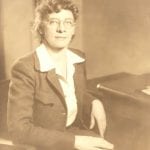
Jessica Park, The Empire State Building with Lightning and Cai Guo-Qiang’s Light Cycle (detail), 2005, collection of Lee Schram
Applied Behavior Analysis
 Applied Behavior Analysis (ABA) originated in the research of Ivar Lovaas and other learning theorists and behaviorists during the 1960s. Their work with autistic children was controversial. Its hallmark was breaking communication and interaction into small behavioral components in order to teach them systematically, in highly structured environments, using both rewards and punishments.
Applied Behavior Analysis (ABA) originated in the research of Ivar Lovaas and other learning theorists and behaviorists during the 1960s. Their work with autistic children was controversial. Its hallmark was breaking communication and interaction into small behavioral components in order to teach them systematically, in highly structured environments, using both rewards and punishments.
Autism Gender Gap
Gender has been key factor in autism’s history. It shaped the earliest definitions of the syndrome, influenced its diagnostic criteria, and oriented researchers and ordinary people alike toward the close alliance between autism and masculinity. Gender helped to set the boundaries around autism, telling us what it was and who could experience it.
Autism in the DSM
 Tracing autism’s history in the Diagnostic and Statistical Manual, the American Psychiatric Association’s detailed reference of diagnoses, reveals how dramatically the diagnosis has evolved since the DSM was first published in 1952.
Tracing autism’s history in the Diagnostic and Statistical Manual, the American Psychiatric Association’s detailed reference of diagnoses, reveals how dramatically the diagnosis has evolved since the DSM was first published in 1952.
Autism, the Term
 The career of autism as a term illuminates the complexity of autism as a historical subject. The word itself has had many points of contact with the history of medicine and psychology as well as the history of development, diagnosis, and disability.
The career of autism as a term illuminates the complexity of autism as a historical subject. The word itself has had many points of contact with the history of medicine and psychology as well as the history of development, diagnosis, and disability.
“Autistic Disturbances of Affective Contact,” 1943
 This iconic 1943 case study by child psychiatrist Leo Kanner is often considered synonymous with the discovery of autism. In it, Kanner described eight boys and three girls seen in his clinic at Johns Hopkins between 1935 and 1943. Their bizarre behavioral similarities helped make autism visible as a novel clinical syndrome.
This iconic 1943 case study by child psychiatrist Leo Kanner is often considered synonymous with the discovery of autism. In it, Kanner described eight boys and three girls seen in his clinic at Johns Hopkins between 1935 and 1943. Their bizarre behavioral similarities helped make autism visible as a novel clinical syndrome.
Brief Introduction to Autism History
Autism’s historical career has been brief and controversial. The term was introduced during the early twentieth century and appeared in the clinical literature in the 1940s. Autism is more familiar and visible today in the United States than ever before, yet we still know remarkably little about its history.
Childhood Psychosis or Schizophrenia
 During the first half of the twentieth century, childhood psychosis and childhood schizophrenia were common labels for children with dramatic behavioral disorders, including children who would be diagnosed with Autism Spectrum Disorder (ASD) today. They were used more or less interchangeably for many decades.
During the first half of the twentieth century, childhood psychosis and childhood schizophrenia were common labels for children with dramatic behavioral disorders, including children who would be diagnosed with Autism Spectrum Disorder (ASD) today. They were used more or less interchangeably for many decades.
Hospitalism
In orphanages and infant asylums, hospital-like institutions that gave hospitalism its name, researchers and clinicians observed a host of autistic-like behaviors in young children, from listlessness and indifference to wasting and rocking.
Mental Retardation
The relationship between autism and mental retardation has been enduring. Autism has overlapped with cognitive impairment, sometimes in paradoxical ways, combining elements of stark cognitive disability with unusual, even extraordinary talent.
Normalization
Normalization was a term associated with deinstitutionalization during the 1970s. It represented a philosophical commitment to the common humanity of people with developmental disabilities, a theoretical rationale for their integration, and a practical blueprint for achieving greater equality by enhancing their social status.
Psychogenesis
The theory that autism had psychological origins was called psychogenesis. Shaped by Freudian perspectives on the interpersonal drama of early life, psychogenesis emphasized mother-infant bonds and early nurture as a powerful engines of development. It explained autism as a response to the emotional deprivation and dehumanization of cold and uncaring parents.
The Siege: The First Eight Years of an Autistic Child, 1967
 The Siege, written by Clara Claiborne Park, was one of the earliest and still most important and beautiful parent memoirs about autism. It describes the siege that Park mounted against the solitude imprisoning her daughter, “Elly,” during the early years of the child’s life.
The Siege, written by Clara Claiborne Park, was one of the earliest and still most important and beautiful parent memoirs about autism. It describes the siege that Park mounted against the solitude imprisoning her daughter, “Elly,” during the early years of the child’s life.